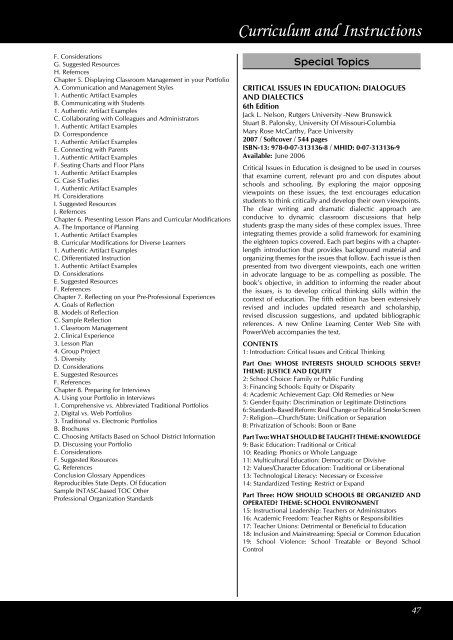table of contents - McGraw-Hill Books
table of contents - McGraw-Hill Books
table of contents - McGraw-Hill Books
Create successful ePaper yourself
Turn your PDF publications into a flip-book with our unique Google optimized e-Paper software.
Curriculum and Instructions<br />
F. Considerations<br />
G. Suggested Resources<br />
H. Refernces<br />
Chapter 5. Displaying Classroom Management in your Portfolio<br />
A. Communication and Management Styles<br />
1. Authentic Artifact Examples<br />
B. Communicating with Students<br />
1. Authentic Artifact Examples<br />
C. Collaborating with Colleagues and Administrators<br />
1. Authentic Artifact Examples<br />
D. Correspondence<br />
1. Authentic Artifact Examples<br />
E. Connecting with Parents<br />
1. Authentic Artifact Examples<br />
F. Seating Charts and Floor Plans<br />
1. Authentic Artifact Examples<br />
G. Case STudies<br />
1. Authentic Artifact Examples<br />
H. Considerations<br />
I. Suggested Resources<br />
J. Refernces<br />
Chapter 6. Presenting Lesson Plans and Curricular Modifications<br />
A. The Importance <strong>of</strong> Planning<br />
1. Authentic Artifact Examples<br />
B. Curricular Modifications for Diverse Learners<br />
1. Authentic Artifact Examples<br />
C. Differentiated Instruction<br />
1. Authentic Artifact Examples<br />
D. Considerations<br />
E. Suggested Resources<br />
F. References<br />
Chapter 7. Reflecting on your Pre-Pr<strong>of</strong>essional Experiences<br />
A. Goals <strong>of</strong> Reflection<br />
B. Models <strong>of</strong> Reflection<br />
C. Sample Reflection<br />
1. Classroom Management<br />
2. Clinical Experience<br />
3. Lesson Plan<br />
4. Group Project<br />
5. Diversity<br />
D. Considerations<br />
E. Suggested Resources<br />
F. References<br />
Chapter 8. Preparing for Interviews<br />
A. Using your Portfolio in Interviews<br />
1. Comprehensive vs. Abbreviated Traditional Portfolios<br />
2. Digital vs. Web Portfolios<br />
3. Traditional vs. Electronic Portfolios<br />
B. Brochures<br />
C. Choosing Artifacts Based on School District Information<br />
D. Discussing your Portfolio<br />
E. Considerations<br />
F. Suggested Resources<br />
G. References<br />
Conclusion Glossary Appendices<br />
Reproducibles State Depts. Of Education<br />
Sample INTASC-based TOC Other<br />
Pr<strong>of</strong>essional Organization Standards<br />
Special Topics<br />
CRITICAL ISSUES IN EDUCATION: DIALOGUES<br />
AND DIALECTICS<br />
6th Edition<br />
Jack L. Nelson, Rutgers University -New Brunswick<br />
Stuart B. Palonsky, University Of Missouri-Columbia<br />
Mary Rose McCarthy, Pace University<br />
2007 / S<strong>of</strong>tcover / 544 pages<br />
ISBN-13: 978-0-07-313136-8 / MHID: 0-07-313136-9<br />
Available: June 2006<br />
Critical Issues in Education is designed to be used in courses<br />
that examine current, relevant pro and con disputes about<br />
schools and schooling. By exploring the major opposing<br />
viewpoints on these issues, the text encourages education<br />
students to think critically and develop their own viewpoints.<br />
The clear writing and dramatic dialectic approach are<br />
conducive to dynamic classroom discussions that help<br />
students grasp the many sides <strong>of</strong> these complex issues. Three<br />
integrating themes provide a solid framework for examining<br />
the eighteen topics covered. Each part begins with a chapterlength<br />
introduction that provides background material and<br />
organizing themes for the issues that follow. Each issue is then<br />
presented from two divergent viewpoints, each one written<br />
in advocate language to be as compelling as possible. The<br />
book’s objective, in addition to informing the reader about<br />
the issues, is to develop critical thinking skills within the<br />
context <strong>of</strong> education. The fifth edition has been extensively<br />
revised and includes updated research and scholarship,<br />
revised discussion suggestions, and updated bibliographic<br />
references. A new Online Learning Center Web Site with<br />
PowerWeb accompanies the text.<br />
CONTENTS<br />
1: Introduction: Critical Issues and Critical Thinking<br />
Part One: WHOSE INTERESTS SHOULD SCHOOLS SERVE?<br />
THEME: JUSTICE AND EQUITY<br />
2: School Choice: Family or Public Funding<br />
3: Financing Schools: Equity or Disparity<br />
4: Academic Achievement Gap: Old Remedies or New<br />
5: Gender Equity: Discrimination or Legitimate Distinctions<br />
6: Standards-Based Reform: Real Change or Political Smoke Screen<br />
7: Religion—Church/State: Unification or Separation<br />
8: Privatization <strong>of</strong> Schools: Boon or Bane<br />
Part Two: WHAT SHOULD BE TAUGHT? THEME: KNOWLEDGE<br />
9: Basic Education: Traditional or Critical<br />
10: Reading: Phonics or Whole Language<br />
11: Multicultural Education: Democratic or Divisive<br />
12: Values/Character Education: Traditional or Liberational<br />
13: Technological Literacy: Necessary or Excessive<br />
14: Standardized Testing: Restrict or Expand<br />
Part Three: HOW SHOULD SCHOOLS BE ORGANIZED AND<br />
OPERATED? THEME: SCHOOL ENVIRONMENT<br />
15: Instructional Leadership: Teachers or Administrators<br />
16: Academic Freedom: Teacher Rights or Responsibilities<br />
17: Teacher Unions: Detrimental or Beneficial to Education<br />
18: Inclusion and Mainstreaming: Special or Common Education<br />
19: School Violence: School Trea<strong>table</strong> or Beyond School<br />
Control<br />
47

















